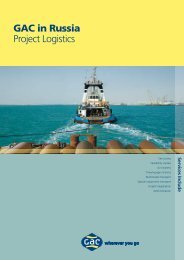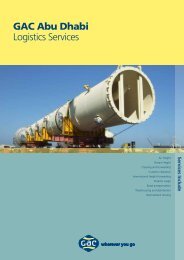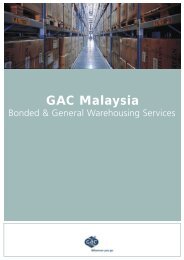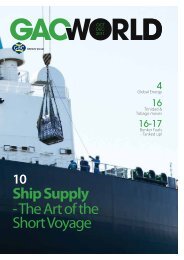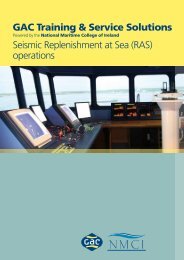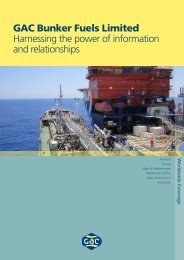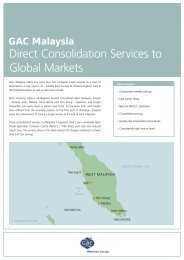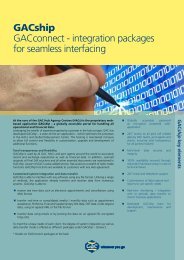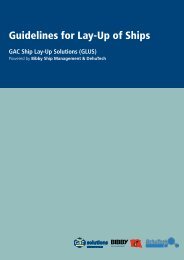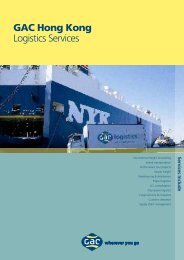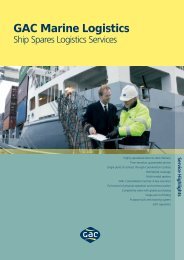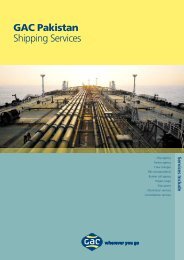GAC WORLD Reshaping the Business World â
GAC WORLD Reshaping the Business World â
GAC WORLD Reshaping the Business World â
Create successful ePaper yourself
Turn your PDF publications into a flip-book with our unique Google optimized e-Paper software.
Wherever you go<br />
<strong>GAC</strong> <strong>WORLD</strong><br />
Newsletter for professionals in shipping and transport No 3 July 2003<br />
<strong>Reshaping</strong> <strong>the</strong><br />
<strong>Business</strong> <strong>World</strong> –<br />
<strong>the</strong> IT Factor<br />
Securing <strong>the</strong> System Page 8<br />
Spam, Spam and Spam Page 10<br />
The Genesis of <strong>the</strong> Internet Page 12<br />
Marine Logistics Service Launched Page 16<br />
Distribution Centre Marks 10th Anniversary Page 17
2 <strong>GAC</strong> <strong>World</strong> 3/2003<br />
Lost in Transit<br />
A selection of<br />
unintentionally funny<br />
announcements<br />
Radio communication<br />
between cockpit and air<br />
traffic controller<br />
Tower: To avoid noise, please turn right<br />
45 degrees.<br />
Pilot: What noise could we possibly make<br />
at 35,000 ft?<br />
Tower: The noise your 707 will make<br />
when colliding with <strong>the</strong> 727 in front of<br />
you.<br />
Quote from an examination<br />
script<br />
To keep milk from turning sour: keep it in<br />
<strong>the</strong> cow.<br />
– I can fly back in time and recover lost backups. What do you do?<br />
A selection from church<br />
bulletins<br />
Ladies, don’t forget <strong>the</strong> rummage sale.<br />
It’s a chance to get rid of those things<br />
not worth keeping around <strong>the</strong> house.<br />
Don’t forget your husbands.<br />
The cost for attending <strong>the</strong> Fasting and<br />
Prayer conference includes meals.<br />
Contents<br />
Editorial by Lars P. Heisselberg, Group Vice President – Shipping Page 3<br />
IT Reshapes <strong>the</strong> <strong>Business</strong> <strong>World</strong> Page 4<br />
<strong>GAC</strong>’s IT Systems for Greater Innovation and Better Service Pages 5 – 7<br />
Securing <strong>the</strong> System Page 8<br />
When <strong>the</strong> System Fails… Page 9<br />
Spam, Spam and Spam Page 10<br />
Wherever You Go: <strong>GAC</strong> IT Professionals Page 11<br />
The Genesis of <strong>the</strong> Internet Pages 12 – 13<br />
Introducing – Gamila Samarasinghe – <strong>GAC</strong> Sri Lanka’s IT Manager Page 14<br />
My Town – Gamila Samarasinghe’s guide to Colombo and its surroundings Page 15<br />
<strong>GAC</strong> Wrap Pages 16 – 18, 20<br />
Industry Insight: Using <strong>the</strong> Sealanes to Revitalise a <strong>World</strong> Economy Page 19<br />
The pastor will preach his farewell<br />
message, after which <strong>the</strong> choir will sing,<br />
”Break Forth Into Joy.”<br />
Contacting <strong>GAC</strong><br />
Want <strong>the</strong> contact details for a <strong>GAC</strong><br />
office or staff member? Go to <strong>the</strong><br />
Directory section of:<br />
www.gacworld.com<br />
Editor: Lars Peter Heisselberg,<br />
Gulf Agency Company Ltd,<br />
Jebel Ali, Dubai, United Arab Emirates<br />
Design: Cross-Border Communication,<br />
Copenhagen, Denmark<br />
Production: Anna Rydén Produktion AB,<br />
Stockholm, Sweden<br />
Correspondence to: Amanda Millen,<br />
TBWA\A<strong>the</strong>ns, 1 Flias Street,<br />
GR-151 22 MAROUSSI, Greece.<br />
Tel +30-210-812 5400, Fax +30-210-812 5480<br />
E-mail amanda.millen@tbwa.gr<br />
Information quoted in this publication has been<br />
obtained from several sources. Whilst every care<br />
has been taken to ensure that details are correct,<br />
<strong>GAC</strong> cannot provide any guarantees <strong>the</strong>reof.<br />
Material in this publication may be freely<br />
quoted, provided <strong>the</strong> source is clearly identified.
Editorial<br />
3<br />
The IT Factor<br />
Once upon a time it was railways and steam<br />
engines that drove <strong>the</strong> economic fortunes<br />
of companies and nations. These days it’s IT,<br />
in its myriad forms, shaping and reshaping<br />
<strong>the</strong> way we work and endlessly expanding<br />
our workday possibilities.<br />
Throughout <strong>the</strong> <strong>GAC</strong> Group <strong>the</strong>re are<br />
systems in place to help us do a better, quicker<br />
and more cost-effective job for our<br />
Customers. Some of our systems link<br />
directly to our Customers’ IT networks to<br />
provide easy access to information, quotes,<br />
forms, regulations and people. Some of<br />
<strong>the</strong>m sit in <strong>the</strong> background, checking, analysing,<br />
watching and protecting. It all adds<br />
up to a globe-spanning network of machines<br />
labouring round <strong>the</strong> clock to serve our<br />
human need for exchanging goods and<br />
information.<br />
As it was with steam engines, IT applications<br />
both help us and challenge us. In <strong>the</strong><br />
Steam Age, some people believed it was not<br />
only impossible but also dangerous to<br />
travel faster than a horse. Now our concerns<br />
centre on <strong>the</strong> new competencies required<br />
to ensure safe and effective use of<br />
our digital helpers. And <strong>the</strong> competencies<br />
demanded of users to run sophisticated<br />
programs pale before those demanded of<br />
our IT managers and developers to select,<br />
set up, train, maintain and upgrade our<br />
systems.<br />
In this edition of <strong>GAC</strong> <strong>World</strong>, we’re taking<br />
a long look at IT – not just <strong>the</strong> systems<br />
we’re using to serve our Customers but <strong>the</strong><br />
issues that arise with <strong>the</strong>ir use – things like<br />
security, Spam and system failures. We’ll<br />
also meet some of <strong>the</strong> people who keep our<br />
mouses clicking.<br />
He, She and IT<br />
The name of Lars Bergström, our IT<br />
Director, crops up regularly in <strong>the</strong> following<br />
pages. This is hardly surprising, given <strong>the</strong><br />
weight of issues Lars has to handle. However,<br />
IT is not exclusively a man’s domain,<br />
as is aptly demonstrated by Gamila Samarasinghe,<br />
our IT Manager in Sri Lanka. Apart<br />
from introducing herself, Gamila offers<br />
some useful tips for anyone venturing down<br />
to <strong>the</strong> Paradise Isle.<br />
An Anniversary<br />
Ten years ago, <strong>GAC</strong> opened its first distribution<br />
centre, at Jebel Ali in <strong>the</strong> United<br />
Arab Emirates. It’s been a good 10 years of<br />
innovation and growth and definitely<br />
something to celebrate. The Jebel Ali facility<br />
is state-of-<strong>the</strong>-art and a keystone in <strong>the</strong><br />
<strong>GAC</strong> Logistics network which, as you will<br />
read, is expanding vigorously to meet <strong>the</strong><br />
needs of global traders.<br />
I hope you find this edition of <strong>GAC</strong><br />
<strong>World</strong> interesting and informative. If <strong>the</strong>re<br />
are o<strong>the</strong>r subjects or issues you would like<br />
to see in <strong>GAC</strong> <strong>World</strong>, please let me know.<br />
Lars P. Heisselberg<br />
Editor<br />
larspeter.heisselberg@gacworld.com
4 IT Reshapes <strong>the</strong> <strong>World</strong><br />
IT Reshapes<br />
<strong>the</strong> <strong>Business</strong> <strong>World</strong><br />
It was less than a decade ago that companies and individuals<br />
realised <strong>the</strong> potential of <strong>the</strong> <strong>World</strong>wide Web as a way of doing<br />
business. Today it is hard to imagine <strong>the</strong> world without it.<br />
Information Technology (IT) now plays a central role in our<br />
lives. It provides tools for communicating, informing, planning,<br />
analysing, organising, entertaining, shopping – <strong>the</strong> list is<br />
daunting and expanding constantly. And now, thanks to<br />
wireless telephony and WAP technology, we can always stay in<br />
touch – wherever we go.<br />
In 1995, <strong>GAC</strong> became <strong>the</strong> first international<br />
shipping agency to launch a website.<br />
Since <strong>the</strong>n, as <strong>the</strong> opportunities offered<br />
by <strong>the</strong> <strong>World</strong>wide Web have grown, so too<br />
has <strong>the</strong> range of IT services and applications<br />
<strong>GAC</strong> offers. Today, <strong>the</strong> Group controls a<br />
huge array of online services and specialist<br />
software to support its services to global<br />
shipping, logistics and marine customers.<br />
Driving Force<br />
Group IT Director, Lars Bergström, has<br />
been a driving force behind <strong>the</strong> development<br />
of <strong>GAC</strong>’s business applications since<br />
he joined <strong>the</strong> Group in 1995. He considers<br />
IT to be vital for future development and<br />
success.<br />
“<strong>GAC</strong> has developed solutions for all our<br />
business operations and activities, tailormade<br />
to meet both our customers’ and partners’<br />
requirements and to support our internal<br />
procedures and processes,” says Lars.<br />
Proper training to ensure maximum<br />
benefits are obtained from <strong>GAC</strong>’s systems<br />
is a priority, he adds.<br />
Internal Applications<br />
<strong>World</strong>wide, <strong>the</strong> <strong>GAC</strong> Group uses a range<br />
of internal applications to ensure seamless<br />
administration and inter-office cooperation.<br />
Lars Bergström says that <strong>GAC</strong> has<br />
standardised its technical infrastructure<br />
and software, ensuring <strong>the</strong>re are no conflicts<br />
between systems.<br />
“The future is here and now,” he adds.<br />
“Within <strong>GAC</strong>, every effort is being made to<br />
use <strong>the</strong> most suitable technology available<br />
to ensure that both our employees and our<br />
customers reap <strong>the</strong> full benefits – wherever<br />
<strong>the</strong>y go.”<br />
The Human Touch<br />
<strong>GAC</strong> has always taken care not to lose<br />
touch with <strong>the</strong> human element, according<br />
to Group President, Lars Säfverström.<br />
He says <strong>the</strong> key to success lies in combining<br />
technological innovations with<br />
<strong>GAC</strong>’s traditional focus on experience,<br />
local knowledge and person-to-person<br />
relationships with Principals.
<strong>GAC</strong>’s IT Systems<br />
5<br />
<strong>GAC</strong>’s IT Systems –<br />
for Greater Innovation and Better Service<br />
On <strong>the</strong> Internet…<br />
<strong>GAC</strong> Online – Group Website<br />
• Launched 1995 and upgraded regularly<br />
since <strong>the</strong>n<br />
• Includes a comprehensive guide to <strong>the</strong><br />
organisation and its services plus:<br />
- Online access to <strong>the</strong> <strong>GAC</strong> address<br />
directory<br />
- Access to <strong>GAC</strong> publications<br />
- Links to local <strong>GAC</strong> companies and<br />
relevant external sites<br />
My<strong>GAC</strong><br />
• Launched November 2000 as<br />
www.mygac.com<br />
• Subscribers can build <strong>the</strong>ir own My<strong>GAC</strong><br />
home page that displays <strong>the</strong> information<br />
<strong>the</strong>y want to see<br />
• Features include <strong>GAC</strong> contact details, a<br />
port directory, maritime news updates<br />
from Reuters, wea<strong>the</strong>r reports, currency<br />
converter<br />
• My<strong>GAC</strong> now has about 4,000<br />
subscribers<br />
Hot Port News<br />
• Hot Port News (HPN) described as “one<br />
of <strong>the</strong> most reliable and up-to-date<br />
sources of information” on port<br />
developments around <strong>the</strong> world<br />
• More than 3,500 My<strong>GAC</strong> subscribers<br />
receive daily HPN bulletins by e-mail<br />
• All My<strong>GAC</strong> members can see <strong>the</strong>se<br />
updates on <strong>the</strong>ir personalised home<br />
pages<br />
• E-mail bulletins can be customised to<br />
feature <strong>the</strong> regions of interest to<br />
subscribers who can also select whe<strong>the</strong>r<br />
or not to receive daily bunker price and<br />
trends reports<br />
• <strong>GAC</strong> remains <strong>the</strong> only international<br />
shipping agency to provide such a<br />
customisable daily news service<br />
• During <strong>the</strong> recent Iraq conflict, HPN<br />
added a daily update on <strong>the</strong> status of<br />
Middle East ports and airports<br />
<strong>GAC</strong> E-News<br />
• Launched July 2002<br />
• E-mail news bulletin giving a round-up of<br />
Corporate news, HPN highlights, an<br />
“Industry Update” section and latest<br />
amendments to <strong>GAC</strong>’s printed Address<br />
Directory<br />
• Distributed monthly<br />
www.gacworld.com – <strong>GAC</strong>’s<br />
new “one stop” Internet<br />
address<br />
• www.gacworld.com launched June 2003<br />
• Incorporates all elements of <strong>the</strong> Group<br />
site, plus My<strong>GAC</strong> and close to 40<br />
individual country and special service<br />
sites<br />
• Includes <strong>the</strong> specialised features of<br />
various local sites such as <strong>the</strong> Suez Canal<br />
toll calculator, updates on Bosphorus and<br />
Dardanelles transits, online logistics<br />
tracking, Ship Supply Service and<br />
accounts functions<br />
continued overleaf >
6 <strong>GAC</strong>’s IT Systems<br />
Continued from page 5.<br />
Shipping<br />
<strong>GAC</strong>Ship<br />
• Launched in October 2002 to support<br />
<strong>GAC</strong>’s Hub Agency operations<br />
• Gives transparency to <strong>GAC</strong>’s hub<br />
activities – Partner agents have direct<br />
access to port cost estimates and cost<br />
control, port call operations control,<br />
funding, and analysis<br />
• Links <strong>the</strong> Group and its network of<br />
Partner agents to selected hub agency<br />
alliance clients<br />
• Network agents can enter up-to-date<br />
information about <strong>the</strong> ports <strong>the</strong>y serve<br />
<strong>GAC</strong>Agent<br />
• <strong>GAC</strong>’s port agent system<br />
• Provides proforma, operations and<br />
disbursement information<br />
• Electronic data interchange (EDI)<br />
facilitates smooth connection between<br />
<strong>GAC</strong>’s and Principals’ accounting systems<br />
• Plans to link <strong>GAC</strong>Agent directly to<br />
<strong>GAC</strong>Ship to give more seamless flow of<br />
information<br />
SAS<br />
• Custom-built Shipping Agency System<br />
• Developed in 1995 to optimise <strong>the</strong> Liner<br />
Shipping Division’s agency services<br />
• Gives liner clients information about<br />
sales, import/export and container<br />
management<br />
• Supports port disbursements for such<br />
operations<br />
• Has facilities for EDI between <strong>the</strong> <strong>GAC</strong><br />
Group’s accounting systems and those of<br />
Principals, Port, and Customs authorities<br />
Ship Supply Services<br />
– Mona Lisa<br />
• Tracks and coordinates provision of<br />
spares and mail, crew changes and<br />
disbursements for SSS jobs<br />
• Allows registered customers to monitor<br />
<strong>the</strong> status of supply jobs being<br />
performed by <strong>GAC</strong> on <strong>the</strong>ir behalf in <strong>the</strong><br />
Middle East<br />
Logistics<br />
Hands-On:<br />
Alwyn Mendonca &<br />
<strong>GAC</strong> Freight<br />
<strong>GAC</strong> Freight: One <strong>World</strong>, One<br />
System<br />
• Facilitiates <strong>the</strong> handling of import and<br />
export documentation for <strong>GAC</strong> sea and<br />
air freight operations around <strong>the</strong> world<br />
<strong>GAC</strong> Track<br />
• <strong>GAC</strong>’s online freight tracking system<br />
• Shipments can be monitored from origin<br />
to final destination, giving complete<br />
cargo visibility and customer peace of<br />
mind<br />
Online Warehouse Management<br />
– Hercules<br />
• Hercules provides information and reports<br />
about transactions and stock balances at<br />
any time and any place<br />
• Gives Principals access to detailed<br />
information about <strong>the</strong>ir stockholding,<br />
imports, exports and statistics at <strong>GAC</strong>’s<br />
warehouses and distribution operations<br />
around <strong>the</strong> world<br />
• <strong>GAC</strong> is this year introducing a new<br />
warehouse management system,<br />
<strong>GAC</strong>Ware<br />
Target<br />
• Freight sales administration and<br />
management system<br />
AirGulf Express and CargoGulf<br />
co-ordination<br />
• Specialised applications co-ordinate, track<br />
and follow-up worldwide cargo traffic<br />
handled by <strong>GAC</strong>’s air freight service,<br />
AirGulf Express, and <strong>the</strong> Group’s Non<br />
Vessel Operating Common Carrier,<br />
CargoGulf<br />
<strong>GAC</strong> Move<br />
• Handles administration and billing of<br />
international moving operations<br />
• Supports surveys, quotations and<br />
communications<br />
• Integrated with <strong>the</strong> Dolphin financial<br />
accounting system<br />
Alwyn Mendonca, <strong>GAC</strong> Hong Kong’s <strong>Business</strong> Manager<br />
for Logistics Services, says <strong>GAC</strong> Freight helps<br />
him manage information relating to customers and<br />
cargo flows.<br />
Its functions cover client booking, preparation of<br />
shipment documents, shipment consolidation and<br />
maintenance of job files. Valuable operational and<br />
statistical reports are generated on a regular basis,<br />
such as weekly and monthly summaries of business<br />
volumes, destinations and carriers used. These reports<br />
are vital for planning and evaluation.<br />
Alwyn says <strong>the</strong> system provides an integrated<br />
tool for <strong>GAC</strong>’s freight forwarding activities, making<br />
it easier for users to complete <strong>the</strong> many tasks<br />
related to such operations. It is also linked to Dolphin,<br />
<strong>the</strong> accounting application used throughout<br />
<strong>the</strong> <strong>GAC</strong> Group.
<strong>GAC</strong>’s IT Systems<br />
7<br />
<strong>GAC</strong> Bunkers<br />
• Supports <strong>GAC</strong>’s bunkering and bunker<br />
trading activities<br />
• Manages operations such as requests,<br />
quotations, nominations and invoicing<br />
P&I – Savior<br />
• Handles <strong>the</strong> administration and billing of<br />
P&I claims for <strong>GAC</strong>’s global network of<br />
P&I Club correspondents<br />
<strong>GAC</strong>SaM<br />
• <strong>GAC</strong>’s central shipping sales and<br />
marketing system<br />
• Collates statistics for all port calls<br />
handled by <strong>GAC</strong>, as well as Principal and<br />
sales visit information<br />
Workshop system – Top Gear<br />
• Tailor-made system supporting <strong>GAC</strong>’s<br />
preventative maintenance, inventory and<br />
purchasing activities<br />
• Ensures efficient workshop operations<br />
and timely maintenance of <strong>GAC</strong> vessels<br />
and vehicles<br />
Hands-On:<br />
Royington Faria & <strong>GAC</strong>Ship<br />
Royington, based in <strong>the</strong> Operations section of <strong>GAC</strong>’s<br />
Dubai Hub Agency Centre, uses <strong>GAC</strong>Ship every day.<br />
He says that one of <strong>the</strong> advantages of <strong>the</strong> system<br />
is that professionals at <strong>GAC</strong>’s Hub Agency Centres<br />
around <strong>the</strong> world have been involved in its<br />
development. This means that it has been built<br />
around <strong>the</strong> needs of <strong>the</strong> people who use it as well<br />
as those of <strong>the</strong> clients it serves.<br />
Royington says <strong>the</strong> system has changed working<br />
processes to such an extent that data input can be<br />
analysed at <strong>the</strong> press of a single button.<br />
“<strong>GAC</strong>Ship is constantly being developed,” he<br />
adds. “But we can safely say that it increases <strong>the</strong><br />
efficiency and productivity of <strong>the</strong> four Hub Agency<br />
Centres and <strong>the</strong> Global Disbursement Centre in<br />
Dubai.”<br />
Marine and Offshore Operations<br />
Hands-On:<br />
Capt. Nick Dorse &<br />
ISM Vessel Reporting System<br />
ISM Vessel Reporting System<br />
• Launched mid 2002<br />
• Facilitates and simplifies ships’ reports on<br />
International Safety Management (ISM)<br />
related matters such as:<br />
- Master’s Hand-over notes<br />
- Chief Engineer’s Hand-over notes<br />
- Onboard familiarisation checklist (for<br />
crew joining vessel)<br />
- Fortnightly safety drills<br />
- Quarterly vessel inspection reports<br />
- Incident reports<br />
<strong>GAC</strong> Marlin<br />
• Support functions for <strong>GAC</strong> Marine such<br />
as a customer database, quote and job<br />
tracking, invoicing, manifests, fleet<br />
position lists and statistics<br />
Capt. Dorse is Master of <strong>the</strong> Anchor Handling Tug<br />
“Mimmi” based with <strong>GAC</strong> Marine in Abu Dhabi. He<br />
is a regular user of <strong>the</strong> ISM Vessel Reporting System.<br />
He says it has greatly simplified <strong>the</strong> task by standardising<br />
<strong>the</strong> reporting format and significantly<br />
reducing <strong>the</strong> volume of paper work. A built-in zip<br />
facility also keeps <strong>the</strong> cost of data transmission to a<br />
minimum.<br />
“Now that computers and ISM have become an<br />
integral part of life at sea, <strong>the</strong> necessity to standardise<br />
reporting or face <strong>the</strong> consequences of lost<br />
records, cluttered computer memories and general<br />
poor housekeeping, is self evident,” he says.<br />
“The use of <strong>the</strong> ISM Vessel Reporting System<br />
plays an important role in addressing that issue.”<br />
There are also plans to expand <strong>the</strong> use of <strong>the</strong> application’s<br />
database to cover o<strong>the</strong>r periodic reports.
8 IT Security<br />
Securing <strong>the</strong> System<br />
Much of <strong>the</strong> coverage of IT<br />
security issues in <strong>the</strong> wider<br />
media is sensationalist,<br />
focusing on nerdy hackers and,<br />
in <strong>the</strong> wake of 9/11, fanatical<br />
terrorists. With our lives now<br />
increasingly dependent on<br />
computers and computer<br />
systems functioning as <strong>the</strong>y<br />
should, <strong>the</strong> fear that some day<br />
something might go wrong is<br />
an easy one for newsproviders<br />
to play on.<br />
Never<strong>the</strong>less, <strong>the</strong>re are<br />
substantial issues surrounding<br />
IT security – issues that have to<br />
be treated with respect.<br />
<strong>GAC</strong> Security<br />
At <strong>GAC</strong>, <strong>the</strong>se issues are handled in hardheaded<br />
fashion by Lars Bergström, Group<br />
IT Director.<br />
“In <strong>GAC</strong>, we take IT security issues very<br />
seriously and our ambition is to minimise<br />
<strong>the</strong> risks and <strong>the</strong> effect a disturbance could<br />
have on our business,” says Lars.<br />
Insecure computers<br />
The continuous growth in <strong>the</strong> power of<br />
computers and constant development of<br />
new software has not made computers any<br />
less vulnerable to attack.<br />
New software such as operating systems<br />
and mail programs invariably contain<br />
security flaws. The sheer complexity of<br />
modern computer programs means that<br />
such flaws are often first noticed after <strong>the</strong><br />
product has been on <strong>the</strong> market for some<br />
time.<br />
The latest Microsoft operating system<br />
Windows XP (released on October 25,<br />
2001) is a case in point. It contained a flaw<br />
in <strong>the</strong> universal plug and play system (UPnP)<br />
that Microsoft <strong>the</strong>mselves described as<br />
“critical” and which, if utilised by a hacker,<br />
could allow <strong>the</strong> intruder to run whatever<br />
scripts <strong>the</strong>y chose on <strong>the</strong> host computer.<br />
The flaw was spotted by a third party a<br />
year after <strong>the</strong> product went on sale.<br />
The increasing use of wireless networks<br />
and <strong>the</strong> Internet throws up new and unexpected<br />
security issues. When wireless networks<br />
(called wireless LANs) first became<br />
available, vendors claimed that it would be<br />
hard for <strong>the</strong> would-be hacker to build <strong>the</strong><br />
sort of receiver necessary to listen in on a<br />
network. This claim proved to be unfounded<br />
and ever since, wireless networks have<br />
been widely perceived as a security risk.<br />
Computer security has become synonymous<br />
in <strong>the</strong> public consciousness with<br />
Internet security.<br />
The Internet gives <strong>the</strong> would-be hacker<br />
remote access to millions of potential<br />
targets in an environment tailor-made for<br />
<strong>the</strong> propagation and distribution of computer<br />
viruses.<br />
Despite <strong>the</strong> widespread use of virus<br />
filtering and detection systems and socalled<br />
firewalls (a protective barrier between<br />
your computer and <strong>the</strong> Internet),<br />
viruses still pose a real threat to <strong>the</strong> security<br />
of Internet-enabled computers. At <strong>the</strong><br />
same time, security flaws in widely used<br />
computer programs mean that <strong>the</strong> well-in-
IT Security<br />
9<br />
When <strong>the</strong> System Fails…<br />
What does a company do if one of its core systems crashes?<br />
<strong>GAC</strong>’s Communication Manager, Kris Zawisza, had to handle such a<br />
situation earlier this year when <strong>the</strong> Group’s e-mail hub went down<br />
for <strong>the</strong> count.<br />
formed hacker has a wide range of potential<br />
ways into your computer.<br />
<strong>GAC</strong> has taken <strong>the</strong>se problems on board<br />
and has developed directives to all <strong>GAC</strong><br />
companies on IT security, as a part of its<br />
Group-wide IT guidelines. In addition, <strong>the</strong><br />
Group has documented policies for IT<br />
security, Internet usage, e-mail usage, computer<br />
virus control, backups and system<br />
access control.<br />
Insecure People<br />
It is not just new programs and systems<br />
that are sometimes insecure.<br />
Users and network administrators have<br />
to learn to operate <strong>the</strong>m in a safe way, something<br />
Lars Bergström is all too aware of.<br />
“It is important that <strong>the</strong> users of a system<br />
are properly trained to know how to<br />
use <strong>the</strong> system to get <strong>the</strong> best business<br />
benefits and avoid misuse which may result<br />
in operational disturbances,” he notes. “It is<br />
equally important that all staff are trained<br />
to understand <strong>the</strong> risk involved and what<br />
policies <strong>GAC</strong> has for IT security, so <strong>the</strong>y<br />
fully understand <strong>the</strong> active role <strong>the</strong>y play in<br />
minimising <strong>the</strong> risks.”<br />
Ultimately it is <strong>the</strong> responsibility of<br />
<strong>GAC</strong> people around <strong>the</strong> world to ensure<br />
that <strong>the</strong> Group’s computers – and <strong>the</strong> information<br />
contained in <strong>the</strong>m – are secure.<br />
At <strong>the</strong> beginning of March, <strong>GAC</strong>’s central<br />
communications hub, provided by Cable &<br />
Wireless (C&W) in <strong>the</strong> UK, suffered a totally<br />
unexpected and irreversible database corruption.<br />
The service had been running reliably<br />
for more than ten years, not only as <strong>the</strong> e-<br />
mail hub for <strong>the</strong> entire <strong>GAC</strong> Group, but also<br />
as a gateway for telex, fax, X400 and<br />
Inmarsat messaging.<br />
As a result of <strong>the</strong> failure, some e-mails<br />
bound for addresses with <strong>the</strong> @gulfagencycompany.com<br />
domain were rejected completely,<br />
while o<strong>the</strong>rs arrived at <strong>the</strong>ir destination<br />
only after a delay. Outgoing e-mails<br />
from <strong>GAC</strong> were partially delivered.<br />
Fortunately, all messages sent to local<br />
<strong>GAC</strong> e-mail domains, such as @gacdxb.com,<br />
@gacsin.com, etc. were received normally.<br />
Immediate response<br />
As soon as Kris became aware of <strong>the</strong><br />
problem, he got in touch with C&W to find<br />
out how long <strong>the</strong> problem would last.<br />
Meanwhile, all offices within <strong>the</strong> <strong>GAC</strong> Group<br />
were advised of <strong>the</strong> failure and instructed to<br />
tell <strong>the</strong>ir clients and contacts to use o<strong>the</strong>r<br />
means of communication until fur<strong>the</strong>r notice.<br />
To ensure that <strong>the</strong> message was received<br />
by as many people as possible, a Communications<br />
Newsflash was also sent to approximately<br />
4,000 My<strong>GAC</strong> subscribers. The<br />
My<strong>GAC</strong> administrative system was fortunately<br />
not affected by <strong>the</strong> problem. Regular<br />
updates were released through My<strong>GAC</strong> until<br />
<strong>the</strong> problem was resolved.<br />
Initially it seemed that <strong>the</strong> system would<br />
be restored quickly and, indeed, it did come<br />
back up. But not for long. When it failed for<br />
a second and final time, Kris discussed <strong>the</strong><br />
problem with Group IT Director, Lars Bergström,<br />
and <strong>the</strong>y agreed that <strong>GAC</strong>’s contingency<br />
plan should be activated. Thanks to<br />
this forward planning, <strong>the</strong>y knew what to do.<br />
Contingency Plan<br />
<strong>GAC</strong>’s contingency plan involved rerouting<br />
e-mails through a backup system in Stockholm.<br />
One of Kris’s main tasks at this stage<br />
was to ensure <strong>the</strong>re was enough hardware<br />
on hand to handle <strong>the</strong> e-mail load. Each<br />
<strong>GAC</strong> office had to change <strong>the</strong> routing instructions<br />
on its e-mail server to direct traffic<br />
to Stockholm. When it became clear that<br />
C&W would not be able to restore <strong>the</strong><br />
service, fur<strong>the</strong>r centralised changes were<br />
completed and since <strong>the</strong>n, <strong>the</strong> system has<br />
been stable.<br />
Because <strong>GAC</strong> had a contingency plan in<br />
place, what could have been a disaster was<br />
converted into merely a regrettable inconvenience.<br />
Kris says <strong>the</strong> system failure<br />
showed firstly that <strong>GAC</strong>’s backup plan works<br />
and secondly that <strong>GAC</strong> people know how to<br />
work pull toge<strong>the</strong>r in a crisis.<br />
“Credit goes to many people, too<br />
numerous to mention, throughout <strong>the</strong> <strong>GAC</strong><br />
Group who showed initiative in passing on<br />
instructions and making sure that those who<br />
needed to be informed were. Once again<br />
‘<strong>the</strong> human network’ proved to be <strong>GAC</strong>’s<br />
best asset.”
10 Spam<br />
Spam Spam and<br />
Spam<br />
Spam is on <strong>the</strong> up<br />
Spam is <strong>the</strong> electronic equivalent of <strong>the</strong><br />
junk mail that clutters up our letterboxes.<br />
Adverts and offers, get-rich-quick schemes,<br />
cheap mortgages and pornography sent via<br />
e-mail are all Spam. It is ubiquitous, unavoidable<br />
and extremely irritating. We’d all<br />
like something done about it, but for anybody<br />
hoping for a Spam-free in-tray, <strong>the</strong> outlook<br />
is bleak.<br />
A year ago, Spam e-mails accounted for<br />
a twelfth of mails sent. As such, <strong>the</strong>y were<br />
more a nuisance than a problem. However,<br />
according to British e-mail filtering firm<br />
Messagelabs Software, by November last<br />
year one in three mails were Spam. Messagelabs<br />
predicts that in 2003, more Spam will<br />
be sent than real e-mails.<br />
Spamming corporate mail<br />
systems<br />
Spam is attractive to <strong>the</strong> unscrupulous<br />
marketer because of <strong>the</strong> sheer volume of<br />
potential customers one can reach at negligible<br />
cost via a Spam “mail shot”. If only a<br />
few of <strong>the</strong>m respond <strong>the</strong>n a profit can be<br />
made.<br />
Blame for <strong>the</strong> recent increase in <strong>the</strong> incidence<br />
of Spam can be laid squarely at <strong>the</strong><br />
door of new tools and appliances which<br />
make <strong>the</strong> spammer’s job easier. E-mail appliance<br />
boxes are available today which will<br />
ship millions of e-mails per hour. Until<br />
recently, Spam mail has been most evident<br />
on popular domains such as hotmail.com,<br />
but new tools and <strong>the</strong> falling cost of bandwidth<br />
have meant that corporate e-mail<br />
systems are becoming increasingly vulnerable.<br />
Spammers with only modest ambitions can<br />
now initiate so-called “dictionary” or “direct<br />
harvest” attacks. In this sort of attack, <strong>the</strong><br />
spammer sends out a multitude of e-mails<br />
to <strong>the</strong> corporate e-mail systems where each<br />
individual e-mail is addressed to a common<br />
name, for example John.Smith@bigcompany.com,<br />
to see what sticks.<br />
The vast majority of mails will be to<br />
non-existent employees but <strong>the</strong> spammer<br />
will be able to harvest a significant number<br />
of genuine addresses. These can <strong>the</strong>n be<br />
sold on to o<strong>the</strong>r spammers and, before <strong>the</strong><br />
week is out, <strong>the</strong> addresses in question can<br />
receive hundreds of junk mails.<br />
Combating Spam<br />
<strong>GAC</strong> has anti-spamming software (as well<br />
as anti-virus software) in place for mail<br />
coming into @gacworld.com, but even <strong>the</strong><br />
best software cannot catch all Spam.<br />
Two strategies can be employed when<br />
trying to catch a spammer.<br />
Firstly, you can filter your incoming mail,<br />
looking for tell-tale signs of Spam in message<br />
titles (for example a series of exclamation<br />
marks, as in “Great Offer!!!!”). One<br />
problem with this approach is that all selfrespecting<br />
spammers have stopped sending<br />
out mails with give-away titles. The o<strong>the</strong>r<br />
problem is that your mum’s message, “Visit<br />
at Christmas!!!!” will be filtered out along<br />
with <strong>the</strong> Spam.<br />
The alternative is to subscribe to e-mail<br />
monitoring services which are able to provide<br />
regular updates about <strong>the</strong> domains<br />
Spam is being sent from. Such services operate<br />
a vast number of dummy e-mail addresses.<br />
These mail addresses receive Spam,<br />
revealing to <strong>the</strong> monitoring company <strong>the</strong><br />
domain from which <strong>the</strong> Spam is being sent.<br />
The monitoring firm can <strong>the</strong>n provide <strong>the</strong>ir<br />
client with a regularly updated list of <strong>the</strong>se<br />
suspect domains, enabling <strong>the</strong> client to<br />
block mail from <strong>the</strong>m. Unfortunately, Spammers<br />
can quickly change <strong>the</strong> domain from<br />
which <strong>the</strong>y send mail. Some is bound to get<br />
through.<br />
Legislating against Spam<br />
Legislators have taken note of <strong>the</strong> increasing<br />
volumes of Spam being sent, and have<br />
tried to do <strong>the</strong>ir bit to stop it.<br />
Great Britain and Denmark are two<br />
countries that have recently changed <strong>the</strong>ir<br />
marketing laws to make it illegal to send<br />
marketing mails without first obtaining <strong>the</strong><br />
recipient’s consent. In Australia, <strong>the</strong> Communications<br />
Minister has announced government<br />
plans to ban Spam by <strong>the</strong> end of this<br />
year. And US lawmakers have introduced a<br />
Bill to provide stiff penalties for e-mail<br />
marketers who disguise <strong>the</strong>ir identities or<br />
use o<strong>the</strong>r deceptions to get into your in-tray.<br />
However, such solutions are of little use<br />
when <strong>the</strong>y only apply to a few countries.<br />
Without an effective tool to beat Spam,<br />
<strong>the</strong> risk is that in-trays will eventually<br />
become so choked that people will turn to<br />
o<strong>the</strong>r ways of communicating. While <strong>the</strong>re<br />
is no sign of this happening at present, <strong>the</strong><br />
chances of such an outcome are increasing<br />
in step with volume of Spam on our screens.<br />
Editor’s note: The Spam problem has sparked<br />
America’s biggest Internet e-mail provider, AOL, to<br />
launch legal action against Spammers. While it may<br />
not reduce <strong>the</strong> amount of Spam in your in-tray, it is<br />
clear evidence that <strong>the</strong> issue is being taken seriously<br />
by those with <strong>the</strong> power to do something about it.
Wherever You Go<br />
11<br />
Wherever You Go:<br />
<strong>GAC</strong> IT Professionals<br />
Around <strong>the</strong> <strong>World</strong><br />
The <strong>GAC</strong> Group’s IT team has<br />
<strong>the</strong> dual task of developing<br />
and implementing systems<br />
that meet <strong>the</strong> needs of both<br />
<strong>the</strong> global organisation and its<br />
large, varied customer base.<br />
Centres of expertise for different technical<br />
areas and applications have been established<br />
throughout <strong>the</strong> Group. These include<br />
specialised teams for <strong>the</strong> Dolphin<br />
financial accounting system, Group Communications<br />
and <strong>GAC</strong>’s anti-virus function.<br />
Group IT Director, Lars Bergström, says<br />
that having such a wealth of IT expertise to<br />
draw upon throughout <strong>the</strong> <strong>GAC</strong> <strong>World</strong> is a<br />
great strength.<br />
Here, we put <strong>the</strong> spotlight on four of <strong>the</strong><br />
professionals who form that strength…<br />
Middle East<br />
When Gopal Krishnan joined <strong>GAC</strong> Oman in<br />
December 1988, his first role with <strong>the</strong><br />
company was totally unrelated to IT. He<br />
started off as a Credit Controller in <strong>the</strong><br />
Finance Department. However, a few<br />
months later, his enthusiasm and interest<br />
in IT was noted and he was assigned to<br />
oversee <strong>the</strong> implementation of <strong>the</strong> new<br />
Cargo Gulf system. For <strong>the</strong> next eight<br />
years, he worked both in Credit Control and<br />
on IT projects.<br />
In 1997, Gopal was appointed IT Manager for<br />
<strong>GAC</strong> Oman. In that capacity, he has played a key<br />
role in <strong>the</strong> design and development of ‘Target’,<br />
<strong>the</strong> Sales Support software program which is<br />
currently being implemented throughout <strong>the</strong> <strong>GAC</strong><br />
organisation. He is also responsible for<br />
implementing <strong>GAC</strong> Freight, <strong>GAC</strong>’s Logistics software<br />
system, throughout <strong>the</strong> Group.<br />
Indian<br />
Subcontinent<br />
Hamid Zaidi arrived<br />
at <strong>GAC</strong> Pakistan in<br />
1996 with ten years<br />
of international IT<br />
experience and a<br />
Masters Degree in<br />
Computer Science<br />
from <strong>the</strong> US.<br />
As <strong>GAC</strong> Pakistan’s Group IT Manager, Hamid is<br />
responsible for IT operations at <strong>GAC</strong> Shipping<br />
Pakistan, <strong>GAC</strong> Logistics Pakistan, United<br />
Marine Agencies Pakistan, Interocean Cargo<br />
Services and <strong>the</strong> Al-Hamd International<br />
Container Terminal .<br />
Since <strong>the</strong> late 1990s, <strong>GAC</strong> Pakistan’s IT<br />
system has evolved from a three-location, 15-<br />
user stand-alone setup into today’s extensive<br />
network that is unrivalled in <strong>the</strong> Pakistan<br />
shipping industry.<br />
Africa<br />
Paul Ajiborisha first<br />
started working with<br />
<strong>GAC</strong> Nigeria as a<br />
contractor in 1995. He<br />
became a full-time<br />
member of <strong>the</strong> <strong>GAC</strong> IT<br />
team in June 1996.<br />
When Paul came on board, HF (SSB Radio), VHF<br />
radio and telex were <strong>the</strong> only reliable means of<br />
communication within Nigeria.<br />
Since <strong>the</strong>n, <strong>GAC</strong> Nigeria has invested heavily<br />
in new communication systems and continues to<br />
do so to enhance its operations.<br />
All <strong>GAC</strong> Nigeria offices are now linked<br />
toge<strong>the</strong>r, ensuring that <strong>the</strong> flow of information is<br />
virtually “real time”.<br />
Europe<br />
For <strong>the</strong> past 12<br />
years, Ali<br />
Moussazadeh has<br />
provided vital IT<br />
support for <strong>the</strong><br />
Group’s UK-based<br />
operations.<br />
Ali’s responsibilities <strong>the</strong> cover technical,<br />
programming and communication issues<br />
for <strong>GAC</strong>’s Sales, Bunker and Hub centres<br />
in London, as well as essential assistance<br />
for his colleagues coordinating operations<br />
in Iran from <strong>the</strong> Crawley office, where he<br />
is based.
12 The Genesis of <strong>the</strong> Internet<br />
The Genesis of <strong>the</strong> Internet<br />
1978 – 2002<br />
1978 1989 1990 1993 1994 1995 1996<br />
On March 26,<br />
Queen Elizabeth II<br />
sends out an e-<br />
mail from <strong>the</strong><br />
Royal Signals and<br />
Radar<br />
Establishment<br />
(RSRE) in Malvern.<br />
The <strong>GAC</strong> Group<br />
starts using<br />
e-mail.<br />
<strong>GAC</strong> introduces its<br />
own tailor-made,<br />
standardised<br />
shipping computer<br />
systems.<br />
Standardised <strong>GAC</strong><br />
Logistics systems<br />
follow in 1992.<br />
The United<br />
Nations comes<br />
online.<br />
<strong>GAC</strong> Marine sets<br />
up its own specialised<br />
applications.<br />
Shopping malls<br />
arrive on <strong>the</strong><br />
Internet.<br />
The first banner<br />
ads appear in<br />
October, on<br />
www.hotwired.com<br />
New arrivals online<br />
during 1995<br />
include The<br />
Vatican and <strong>the</strong><br />
Canadian Government.<br />
1995 also sees <strong>the</strong><br />
launch of <strong>the</strong> first<br />
<strong>GAC</strong> website.<br />
On January 17,<br />
Malaysian<br />
Prime Minister<br />
Mahathir<br />
Mohamad,<br />
PLO Leader Yasser<br />
Arafat and<br />
Philippine<br />
President Fidel<br />
Ramos “meet” for<br />
ten minutes in an<br />
online chat<br />
session.<br />
The Internet has brought<br />
about new ways of working,<br />
new ways of selling goods<br />
and services and new ways<br />
of accessing information.<br />
What is more, <strong>the</strong> Internet is<br />
a uniquely “democratic”<br />
medium – surprising when<br />
one considers that it is a<br />
product of <strong>the</strong> Cold War.<br />
A unique medium<br />
The Internet is essentially a lot of computers<br />
joined toge<strong>the</strong>r in a network. When<br />
so linked, <strong>the</strong>se computers are able to exchange<br />
information with each o<strong>the</strong>r. Thus,<br />
on <strong>the</strong> Internet, every user can be both a<br />
sender and a receiver of information.<br />
It is this ability to exchange information<br />
that distinguishes <strong>the</strong> Internet from traditional<br />
broadcast mass media such as TV<br />
and radio where <strong>the</strong>re is only one sender of<br />
information. That unique feature can be<br />
captured in a single word: interactivity.<br />
Unusual features<br />
The Internet has several unusual features<br />
when compared with o<strong>the</strong>r man-made networks.<br />
Information travelling on <strong>the</strong> Internet<br />
does not take <strong>the</strong> shortest or most efficient<br />
route between two points. Whenever you<br />
send information over <strong>the</strong> Internet, it does<br />
not travel as a discrete compact entity but<br />
is broken up into “packets” (small nuggets<br />
of information), each of which takes its<br />
own individual and quite different route to<br />
its destination.<br />
Fur<strong>the</strong>rmore, <strong>the</strong> Internet is unusual in<br />
having no central controlling body. These<br />
features of <strong>the</strong> Internet’s basic design were<br />
developed as a way of securing <strong>the</strong> transfer<br />
of information in <strong>the</strong> event of a nuclear war.<br />
Cold War thinking<br />
In <strong>the</strong> late 1960s, <strong>the</strong> RAND Corporation,<br />
America’s foremost Cold War think-tank,<br />
was concerned that <strong>the</strong> communication<br />
systems which bound <strong>the</strong> nation toge<strong>the</strong>r<br />
were vulnerable to attack. Both TV and<br />
telephone systems could be wiped out by a<br />
few well-placed bombs. Destroying key<br />
telephone exchanges or television transmitters<br />
would cripple <strong>the</strong>se systems and, without<br />
<strong>the</strong>m, it would be difficult to<br />
coordinate <strong>the</strong> defence of <strong>the</strong> nation.<br />
In order to overcome this problem a new<br />
communication network was developed.<br />
ARPANET was commissioned by <strong>the</strong><br />
Pentagon in 1969 to allow researchers to<br />
share <strong>the</strong> precious processor power of <strong>the</strong>
The Genesis of <strong>the</strong> Internet<br />
13<br />
1996 1997 1998 1999 2000 2001 2002<br />
<strong>GAC</strong>’s Ship Supply<br />
Services interactive<br />
online application<br />
is launched.<br />
<strong>GAC</strong> introduces its<br />
Inventory-Online<br />
service.<br />
Electronic<br />
postal stamps<br />
become a reality,<br />
with <strong>the</strong> US Postal<br />
System allowing<br />
stamps to be<br />
purchased and<br />
downloaded for<br />
printing from <strong>the</strong><br />
Web.<br />
In April, a forged<br />
web page made<br />
to look like a<br />
Bloomberg<br />
financial news<br />
story raises <strong>the</strong><br />
share price of a<br />
small technology<br />
company by 31%.<br />
The domain<br />
“business.com” is<br />
sold for US$ 7.5<br />
million in 1999. It<br />
had been<br />
purchased for US$<br />
150,000.<br />
On January 1,<br />
<strong>the</strong> US timekeeper<br />
and some o<strong>the</strong>r<br />
time services<br />
around <strong>the</strong> world<br />
report <strong>the</strong> new<br />
year as 19100.<br />
<strong>GAC</strong> Accounts<br />
come online.<br />
<strong>GAC</strong> Track comes<br />
online.<br />
<strong>GAC</strong>’s<br />
customisable, subscriber-based<br />
site<br />
www.mygac.com is<br />
launched followed<br />
by <strong>GAC</strong>’s Hot Port<br />
News daily<br />
e-mail bulletin.<br />
<strong>GAC</strong> sends out<br />
<strong>the</strong> first edition of<br />
its monthly <strong>GAC</strong><br />
E-News e-mail<br />
bulletin in July.<br />
supercomputers of <strong>the</strong> day. When designing<br />
<strong>the</strong> telephone network, <strong>the</strong> engineers<br />
responsible had tried to make <strong>the</strong> system as<br />
efficient as possible. Thus, messages took<br />
<strong>the</strong> shortest route between two points.<br />
ARPANET took ano<strong>the</strong>r principle as its<br />
point of departure – robustness. A message,<br />
once sent, should be able to reach its destination<br />
even if <strong>the</strong> network it was sent on had<br />
been blown full of holes by a nuclear<br />
attack.<br />
Thus, for <strong>the</strong> Internet, <strong>the</strong>re is no central<br />
agency responsible for maintaining <strong>the</strong><br />
network. Nor is information sent along predetermined<br />
routes which, in <strong>the</strong> event of<br />
part of <strong>the</strong> route being destroyed, would<br />
stop <strong>the</strong> message reaching its destination.<br />
Packets of Internet information travel one<br />
step at a time in <strong>the</strong> general direction of<br />
<strong>the</strong>ir final destination.<br />
ARPANET to Internet<br />
Within two years of its start-up, <strong>the</strong> main<br />
traffic on ARPANET was not long-distance<br />
computing but electronic post – e-mail. Expanding<br />
ARPANET was easy because, unlike<br />
conventional networks, computers did<br />
not have to be of <strong>the</strong> same type to join it. It<br />
was sufficient that <strong>the</strong>y talked <strong>the</strong> “packet<br />
switching” language of <strong>the</strong> day, <strong>the</strong> TCP/IP<br />
protocol.<br />
It was out of ARPANET that <strong>the</strong> Internet<br />
we know today was born.<br />
O<strong>the</strong>r networks used <strong>the</strong> TCP/IP protocol<br />
to connect to ARPANET from <strong>the</strong> late<br />
1970s and, eventually, ARPANET was swallowed<br />
up by <strong>the</strong> child it created.<br />
Democratic medium<br />
The lack of a central controlling body on <strong>the</strong><br />
Internet means that anybody can connect<br />
<strong>the</strong>ir computer to it and begin exchanging<br />
information with o<strong>the</strong>r users. Had <strong>the</strong> Internet<br />
been devised with a central body determining<br />
<strong>the</strong> route information took across<br />
<strong>the</strong> network, it would have been far easier<br />
to control how information was exchanged<br />
and by whom.<br />
Thus, a democratic and decentralised medium<br />
was born, created as a by-product of<br />
Cold War fears of nuclear war.<br />
Interestingly, <strong>the</strong> Internet became a<br />
dominant news and information medium<br />
during <strong>the</strong> recent conflict in Iraq. People<br />
from all over <strong>the</strong> world clicked into a variety<br />
of news sources on <strong>the</strong> net to find out what<br />
was happening. While not supplanting <strong>the</strong><br />
traditional news media, <strong>the</strong> Internet demonstrated<br />
its capacity to fulfil <strong>the</strong> information<br />
needs of people across <strong>the</strong> world’s<br />
time zones.
14 Introducing<br />
Gamila Samarasinghe<br />
– <strong>GAC</strong> Sri Lanka’s IT Manager<br />
Gamila Samarasinghe in brief<br />
Born<br />
1968 in Colombo, Sri Lanka<br />
Joined <strong>GAC</strong> October 1995<br />
Post held<br />
Family<br />
Hobbies<br />
IT Manager<br />
Married to Induka<br />
Graphic design, computer<br />
animation, photography<br />
I was born in Colombo, <strong>the</strong> commercial<br />
capital of Sri Lanka. My childhood was filled<br />
with fairytale characters, heroes and<br />
heroines pasted around <strong>the</strong> walls of our<br />
family home. These were <strong>the</strong> creations of<br />
my fa<strong>the</strong>r, a painter and professional cartoonist.<br />
After completing my secondary education,<br />
I was drawn by <strong>the</strong> world of computers<br />
as I was fascinated by <strong>the</strong>ir potential<br />
for doing amazing things. My eagerness to<br />
learn <strong>the</strong> intricacies of this sphere we now<br />
call Information Technology led me to take<br />
several IT courses and professional exams.<br />
I started my first job in 1994, as an assistant<br />
in <strong>the</strong> documentation section of Sri<br />
Lankan shipping company, McLarens. I felt<br />
confident that <strong>the</strong> insights offered into <strong>the</strong><br />
business processes of <strong>the</strong> shipping world<br />
would stand me in good stead for my<br />
future career.<br />
Sure enough, as my first year with<br />
McLarens was drawing to an end, luck came<br />
my way when I heard of an opening for a<br />
systems administrator at a company called<br />
<strong>GAC</strong> Sri Lanka, which was formed as a joint<br />
venture with McLarens.<br />
Then, <strong>GAC</strong> Sri Lanka was still in its first<br />
phase of growth and had just three computers<br />
and less than ten employees. At first, it<br />
was my task to help my new colleagues get<br />
familiar with working with computers. I also<br />
wrote a few computer programs to automate<br />
<strong>the</strong> business process.<br />
Those first few years proved to be a<br />
terrific and valuable learning experience,<br />
both for me and my colleagues at <strong>GAC</strong>.<br />
With <strong>the</strong> passage of time, <strong>the</strong> company<br />
steadily grew, and more and more business<br />
units were added. Naturally, this kept me<br />
extremely busy, improving <strong>the</strong> company’s<br />
IT infrastructure, automation and communication<br />
systems. The help and support of<br />
my husband, Induka, <strong>the</strong> IT Manager for<br />
<strong>the</strong> McLarens Group of Companies, was<br />
especially valuable during that period.<br />
My job at <strong>GAC</strong> Sri Lanka has never been<br />
routine – sometimes it involves implementing<br />
new solutions, whilst at o<strong>the</strong>r times I<br />
find myself “trouble shooting” or trying to<br />
resolve user demands and problems. I have<br />
also played a key role in <strong>the</strong> design and<br />
launch of <strong>GAC</strong> Sri Lanka’s local website.<br />
Today, <strong>GAC</strong> Sri Lanka has 60 computers<br />
and four servers – a figure that looks set to
Introducing / My Town<br />
15<br />
My Town<br />
As a native of Sri Lanka’s commercial capital, Gamila has<br />
plenty of tips for visitors to Colombo and fur<strong>the</strong>r afield.<br />
increase fur<strong>the</strong>r. To meet <strong>the</strong> additional<br />
demands this brings, I have recently been<br />
joined by an assistant in <strong>the</strong> IT department.<br />
The constantly changing nature of Information<br />
Technology means that I have to<br />
keep myself up-to-date with <strong>the</strong> latest developments,<br />
which I do by regularly attending<br />
professional IT courses.<br />
Away from work, I consider myself very<br />
lucky to live in Sri Lanka, which is also<br />
known as <strong>the</strong> Paradise Isle. It is a land<br />
packed with exciting sights and fascinating<br />
places to explore. Induka and I take every<br />
opportunity to explore <strong>the</strong> rich diversity of<br />
our homeland in <strong>the</strong> company of good<br />
friends. These trips have taken us to <strong>the</strong><br />
four corners of <strong>the</strong> island, including Jaffna,<br />
Sri Lanka’s nor<strong>the</strong>rn-most city which was<br />
previously not accessible due to <strong>the</strong> civil<br />
war of <strong>the</strong> past two decades. That particular<br />
trip was quite an experience, with a<br />
distinct element of risk involved, thanks to<br />
a variety hazards and “unknowns” like uncleared<br />
landmines.<br />
It is during <strong>the</strong>se trips that I have started<br />
trying my hand at photography in a bid to<br />
try to capture some of <strong>the</strong> splendour of Sri<br />
Lanka.<br />
Something else I like to do with my<br />
spare time again involves computers but<br />
also pays some homage to my fa<strong>the</strong>r’s creations.<br />
I love to experiment with graphics<br />
and animation and it is my dream to use a<br />
computer and its tools to create something<br />
like what my fa<strong>the</strong>r creates with paintbrushes<br />
and paper.<br />
In closing, I would like to extend a wish<br />
for prosperity and a lasting peace in my<br />
beloved land – Sri Lanka.<br />
Best way to get around<br />
Colombo’s metred taxis have yellow tops<br />
and red-on-white number-plates. Make sure<br />
<strong>the</strong> driver completely understands where<br />
you want to go.<br />
If you want to beat <strong>the</strong> traffic, catch a<br />
three-wheeler. They’re quick, but you have<br />
to bargain hard!<br />
Favourite place to eat<br />
There are plenty of roadside eating places<br />
throughout <strong>the</strong> city, in addition to plush<br />
restaurants serving a wide range of cuisines<br />
– from Continental to Oriental.<br />
My personal favorite is <strong>the</strong> “Gallery Café”,<br />
where you can enjoy your dinner under <strong>the</strong><br />
stars.<br />
Best Hotels<br />
Colombo has a number of five-star hotels.<br />
However, my pick would be <strong>the</strong> Kandalama<br />
Hotel in Dambulla. This hotel in within <strong>the</strong><br />
jungle, and <strong>the</strong> view from <strong>the</strong> swimming<br />
pool is like a painting!<br />
Shopper’s Delight<br />
The city is a veritable shopper’s paradise,<br />
where you can enjoy <strong>the</strong> noise and bustle of<br />
a colourful street bazaar – Colombo <strong>World</strong><br />
Market – or step into <strong>the</strong> elegant atmosphere<br />
of a fashionable boutique in one of<br />
Colombo’s newest shopping malls.<br />
Where to Go<br />
Yearning for a sandy beach and <strong>the</strong> splash<br />
of <strong>the</strong> waves but too lazy to drive too far<br />
out? Then head for Mount Lavinia, just<br />
eight miles from Colombo, where <strong>the</strong> sand<br />
is soft and <strong>the</strong> sea calm and clear.<br />
City Sights<br />
At Galle Face Green, in <strong>the</strong> centre of<br />
Colombo, you can experience political discussions,<br />
vendors and kite flyers. Spending a<br />
few hours <strong>the</strong>re will give you <strong>the</strong> opportunity<br />
to see <strong>the</strong> many faces of <strong>the</strong> city. You<br />
can end <strong>the</strong> day by watching a performance<br />
of dancing elephants in <strong>the</strong> Dehiwala Zoo,<br />
one of <strong>the</strong> finest in Asia.<br />
Out of Town<br />
If you have more time, head south about<br />
190 miles to Ruhuna Park at Yala, Sri Lanka’s<br />
most popular wild safari destination. What<br />
makes this park unique is <strong>the</strong> huge variety<br />
of habitats it contains, including dense<br />
jungles, lagoons, a beautiful sea front and<br />
rocky outcrops.<br />
Alternatively, drive towards Kandy, and<br />
on your way visit <strong>the</strong> Pinnawela Elephant<br />
Orphanage, where you can mingle with<br />
about 70 elephants or watch <strong>the</strong>m taking a<br />
bath in <strong>the</strong> nearby river.<br />
Or visit <strong>the</strong> Sigirya Rock Fortress, <strong>the</strong><br />
citadel of King Kassapa, where you can<br />
climb <strong>the</strong> rock to see <strong>the</strong> renowned Sigirya<br />
Frescoes.<br />
Don’t miss<br />
A genuine Sri Lankan cup of tea. It is not just<br />
<strong>the</strong> tea that invigorates – <strong>the</strong> beautiful<br />
rolling green hills and valleys where <strong>the</strong> tea<br />
grows, studded with silvery streams and<br />
waterfalls, captivate <strong>the</strong> eye and <strong>the</strong> mind.<br />
Best Avoided<br />
Colombo mosquitoes – make sure you are<br />
well stocked with repellant!<br />
Best Thing About The Place<br />
Colombo is a fascinating city, not only<br />
because of its comfortable mix of East and<br />
West, but also its easy blend of past and<br />
present.
16 <strong>GAC</strong> Wrap<br />
Regional Managers<br />
to Drive Logistics<br />
Growth<br />
Marine Logistics Service Launched<br />
<strong>GAC</strong> has combined its extensive experience in<br />
shipping, logistics and marine services to offer ship<br />
owners and spares suppliers an integrated door-tovessel<br />
solution.<br />
A new <strong>GAC</strong> company, <strong>GAC</strong> Marine Logistics<br />
Inc., will provide global supply chain management<br />
services to meet <strong>the</strong> demand for fast<br />
and efficient delivery of ship spares and<br />
marine parts.<br />
The new company and its services will be<br />
profiled in <strong>the</strong> next edition of <strong>GAC</strong> <strong>World</strong>.<br />
“Since <strong>the</strong> start of this year, all <strong>GAC</strong> Logistics<br />
offices around <strong>the</strong> world have been able to<br />
file manifests electronically and get <strong>the</strong><br />
green light from US Customs in a matter of<br />
minutes,” says Bill Hill, Group Vice President,<br />
Logistics Services.<br />
“Our customers benefit from <strong>GAC</strong>’s<br />
understanding of <strong>the</strong> process as many in our<br />
industry, including some of <strong>the</strong> shipping<br />
lines, are unclear about what is required.<br />
<strong>GAC</strong> can allay this concern for <strong>the</strong> exporter.”<br />
Benefits<br />
Direct AMS filing offers significant benefits<br />
to customers. It provides tighter security<br />
throughout a customer’s supply chain, and<br />
because <strong>the</strong> manifest data is checked<br />
thoroughly before cargoes are loaded, it<br />
reduces <strong>the</strong> risk of attracting fines or having<br />
<strong>the</strong> manifest rejected. Accurate filing of<br />
manifest information also ensures timely<br />
Enquiries can be addressed to:<br />
<strong>GAC</strong> MARINE LOGISTICS INC.<br />
<strong>GAC</strong> Distribution Centre, Jebel Ali,<br />
P O Box 17041,<br />
Dubai, United Arab Emirates<br />
Tel: +971-4-881 8090, 805 9450 (24 hours)<br />
Fax: +971-4-881 1177<br />
E-mail: gml@gacworld.com<br />
Cables: ‘Confidence’, Dubai<br />
Logistics Lifts Service with AMS Compliance<br />
<strong>GAC</strong> Logistics has successfully integrated <strong>the</strong> US<br />
Customs’ Automated Manifest System (AMS)<br />
requirements into its supply chain management<br />
procedures.<br />
loading of cargo at origin and avoids delays<br />
on arrival at US ports.<br />
“To date, our customers have been very<br />
supportive and have provided accurate<br />
manifest details well in advance of <strong>the</strong><br />
planned sailing date. Once we have <strong>the</strong><br />
information, our customers can be assured<br />
we will take care of <strong>the</strong> rest,” adds Bill Hill.<br />
Extensive testing and evaluation of <strong>the</strong><br />
AMS procedures have been carried out over<br />
<strong>the</strong> past few months along with training for<br />
<strong>GAC</strong> Logistics’ staff.<br />
The AMS certification is part of <strong>GAC</strong><br />
Logistics’ ongoing plans to comply with all<br />
new security measures introduced by <strong>the</strong> US<br />
since <strong>the</strong> terrorist attacks in September<br />
2001. O<strong>the</strong>r initiatives include membership<br />
application for <strong>the</strong> Customs-Trade Partnership<br />
Against Terrorism (C-TPAT) programme,<br />
and a review of <strong>GAC</strong> Logistics’ internal<br />
documentation, operational procedures and<br />
guidelines.<br />
Gunnar Lundgren<br />
– Regional Logistics Manager: Europe,<br />
Mediterranean & Africa<br />
Gunnar was appointed<br />
in April and is based in<br />
Bahrain where he is responsible<br />
for driving<br />
<strong>GAC</strong>’s logistics business<br />
in <strong>the</strong> Europe,<br />
Mediterranean & Africa<br />
region, including developing<br />
and implementing<br />
regional sales strategies, reviewing<br />
service standards and building relations with<br />
key customers and partners.<br />
Gunnar has more than 25 years of freight<br />
forwarding experience in <strong>the</strong> international<br />
logistics arena. Prior to his new appointment,<br />
he had been <strong>the</strong> Product Manager for <strong>GAC</strong>’s<br />
airfreight service, AirGulf Express, since 1995.<br />
Mikael Jinglöv<br />
– Regional Development Manager, 3PL,<br />
Asia Pacific & Indian Subcontinent<br />
Mikael’s appointment<br />
puts him in charge of<br />
Third Party Logistics in<br />
Asia and <strong>the</strong> Indian<br />
Subcontinent .<br />
Based in Malaysia,<br />
Mikael is responsible<br />
for charting and implementing<br />
long-term strategic<br />
plans, as well as developing new supply<br />
chain products and services. He reports to<br />
Christer Sjödoff, Regional Director, <strong>GAC</strong><br />
Asia Pacific and <strong>the</strong> Indian Subcontinent.<br />
Mikael’s appointment is part of <strong>GAC</strong> Logistics’<br />
on-going plan to dedicate more<br />
management resources to identify new<br />
markets and expand existing ones.<br />
Prior to his new appointment, Mikael was<br />
General Manager of <strong>GAC</strong> Logistics Inc. in<br />
<strong>the</strong> Philippines.<br />
Joiner<br />
Maloy Kr. Dutta<br />
Born in Murshidabad,<br />
West Bengal, India, in<br />
1966, Maloy joined<br />
<strong>GAC</strong> Calcutta in April<br />
2003 as Branch Manager.
<strong>GAC</strong> Wrap<br />
17<br />
Distribution Centre Marks<br />
10th Anniversary<br />
with Record<br />
<strong>GAC</strong>’s flagship Distribution Centre in Jebel Ali, Dubai,<br />
has celebrated 10 successful years of operation with a<br />
record throughput of 3,000 TEUs in March - <strong>the</strong><br />
highest volume attained since <strong>the</strong> Centre opened.<br />
What started out as an 8,000m 2 storage<br />
space has expanded six-fold to become a<br />
50,000m 2 state-of-<strong>the</strong>-art facility today,<br />
housing <strong>the</strong> inventories of more than 60<br />
major corporations from such diverse sectors<br />
as retail, FMCG (Fast Moving Consumer<br />
Goods), automotive and frozen food.<br />
It now has more than 55,000 pallet positions,<br />
108 loading bays and a 300-strong<br />
workforce offering end-to-end supply chain<br />
management solutions, including inbound<br />
logistics, warehousing, retail distribution<br />
and value added services.<br />
“Our 10th anniversary offers a unique<br />
opportunity to reflect on many past achievements,”<br />
says Dag Bore, General Manager,<br />
Logistics Division, <strong>GAC</strong> Dubai. “It also challenges<br />
us to look ahead and create a vision<br />
for continuing success in <strong>the</strong> future.”<br />
Breaking New Ground<br />
As <strong>the</strong> first independent distribution centre<br />
in <strong>the</strong> region, <strong>the</strong> <strong>GAC</strong> facility has pioneered<br />
a number of developments in <strong>the</strong><br />
regional logistics industry.<br />
One significant milestone was <strong>the</strong> development<br />
of its warehouse management<br />
system.<br />
The Centre’s success also supported <strong>the</strong><br />
development of <strong>GAC</strong>’s pan-Gulf road transport<br />
network, which now handles about<br />
200 trucking assignments per month. <strong>GAC</strong>’s<br />
truck fleet includes temperature-controlled<br />
and dual compartment vehicles for<br />
transporting <strong>the</strong> widest possible range of<br />
goods.<br />
The past decade has also seen <strong>the</strong><br />
Centre’s customer base expand from specialising<br />
in <strong>the</strong> FMCG sector to include <strong>the</strong><br />
handling of perishable food products, hightech<br />
spare parts and hanging garments.<br />
It now manages an increasing number of<br />
blue-chip accounts across a broad range of<br />
industries.<br />
Staying Ahead<br />
Dag Bore says <strong>the</strong> Centre’s success has<br />
required vision, careful business planning<br />
10 years ago<br />
and research. He sees fur<strong>the</strong>r developments<br />
arising out of <strong>the</strong> Group’s new business<br />
plan, Vision X – Global Reach, which sets<br />
<strong>the</strong> framework for extending <strong>the</strong> Group’s<br />
global presence while integrating and diversifying<br />
its range of services.<br />
“The facility has undergone many major<br />
structural developments over <strong>the</strong> years and<br />
<strong>the</strong>y are still happening. By <strong>the</strong> end of 2003,<br />
we will increase our capacity by ano<strong>the</strong>r<br />
20 per cent.<br />
“We’re also looking to introduce more<br />
specialised supply chain and value-added<br />
solutions and to expand our logistics consultancy<br />
services,” he says.<br />
Back in 1993, <strong>the</strong> <strong>the</strong>n Managing Director of <strong>GAC</strong> Dubai, Rolf Murchardt, had <strong>the</strong> task<br />
of bringing <strong>GAC</strong>’s newest facility on line. He recalls <strong>the</strong> many discussions and deadline<br />
challenges that were overcome to get <strong>the</strong> Centre’s doors open.<br />
The <strong>the</strong>n chairman of <strong>the</strong> Jebel Ali Free Trade Zone, Sheikh Sultan bin Sulayem, suggested<br />
that Rolf’s plan to open <strong>the</strong> centre in January 1993 was unreachable. But Rolf<br />
had <strong>the</strong> last laugh.<br />
“I called His Highness in <strong>the</strong> first week of January and asked if he would be willing<br />
to come out and cut <strong>the</strong> ribbon and I’ll never forget his face when he arrived with his<br />
retinue and a truck drove out of one of <strong>the</strong> five huge gates.<br />
“On that truck was a pallet dressed in red velvet and on <strong>the</strong> velvet was a red cushion<br />
– and on <strong>the</strong> cushion was a pair of gold scissors to cut <strong>the</strong> red ribbon surrounding <strong>the</strong><br />
complex.<br />
“He looked at me and remarked that <strong>the</strong>re were no photographers present at which<br />
point I pressed a remote control I had in my pocket and ano<strong>the</strong>r gate opened in front<br />
of us and <strong>the</strong>re stood about twenty photographers waiting to record <strong>the</strong> event.<br />
“We walked in and everything was neat and clean and <strong>the</strong>re were racks of pallets<br />
all stacked up. We were definitely open for business.”
18 <strong>GAC</strong> Wrap<br />
Logistics Expansion in South Africa<br />
<strong>GAC</strong> Logistics has established<br />
three new offices in South<br />
Africa as part of <strong>the</strong> Group’s<br />
global-reach strategy to<br />
provide logistics solutions<br />
wherever its customers go.<br />
The offices, in Cape Town,<br />
Johannesburg, and Durban,<br />
provide a full range of freight<br />
forwarding and warehousing<br />
services.<br />
Setting up logistics operations in South Africa<br />
is a natural progression for <strong>the</strong> company, says<br />
Bill Hill, Group Vice President, Logistics<br />
Division.<br />
“<strong>GAC</strong> has been offering shipping agency<br />
services in South African markets since<br />
1998,” he says. “The decision to extend our<br />
logistics operations here will streng<strong>the</strong>n our<br />
ability to create a ‘one world-one partner’<br />
value proposition for our customers.”<br />
The new offices aim to harness <strong>the</strong> growing<br />
demand for integrated and customised<br />
solutions in South Africa, says Vivian Wright,<br />
General Manager, <strong>GAC</strong> Logistics in South<br />
Africa.<br />
”We are seeing a trend where customers<br />
are becoming more global, resulting in an increase<br />
in <strong>the</strong> scale and complexity of <strong>the</strong>ir<br />
logistics requirements, which <strong>the</strong>y prefer to<br />
outsource.”<br />
South Africa is a key economic driver for <strong>the</strong><br />
whole of Africa, contributing close to a<br />
quarter of <strong>the</strong> continent’s GDP. It is a strong<br />
manufacturing and distribution base for food<br />
and beverages, tobacco, furniture, textiles,<br />
lea<strong>the</strong>r, and electrical goods.<br />
Vivian says her immediate priorities are to<br />
promote <strong>the</strong> <strong>GAC</strong> Logistics brand and <strong>the</strong><br />
Division’s capabilities as a global solution<br />
provider, drawing on <strong>the</strong> global purchasing<br />
power of <strong>GAC</strong>’s international network to<br />
offer more competitive rates.<br />
Top The <strong>GAC</strong> Logistics team in South Africa<br />
(left to right): Sipho Makhomboti, Indrin Moodley,<br />
Lynette Agrella, Paulus Mabotha, Vivian Wright,<br />
Marilyn Marks, Shirley Cooper, Tanya Van Enter,<br />
Lizaan Jansen Van Rensburg.<br />
Right Vivian Wright, General Manager of<br />
<strong>GAC</strong> Logistics in South Africa.<br />
<strong>GAC</strong> Appointed For Iraq Aid Operation<br />
The United Nations’ <strong>World</strong> Food Programme (WFP) has<br />
appointed <strong>GAC</strong> to handle aid shipments for Iraq in what<br />
looks set to be <strong>the</strong> largest humanitarian aid operation<br />
ever undertaken.<br />
During <strong>the</strong> coming six months, it is estimated<br />
that more than 1.6 million metric tons<br />
of food aid will be shipped into Iraq.<br />
Shipments are being handled by <strong>GAC</strong><br />
Dubai, in liaison with <strong>the</strong> Group’s network of<br />
operations offices throughout <strong>the</strong> Middle<br />
East.<br />
Group President, Lars Säfverström, says<br />
<strong>GAC</strong> is well suited to take on this massive<br />
task, thanks to its extensive regional shipping<br />
and logistics infrastructure, which includes<br />
<strong>the</strong> giant Jebel Ali Distribution Centre<br />
near Dubai.<br />
“<strong>GAC</strong> has been a part of <strong>the</strong> Gulf community<br />
for nearly half a century,” he says.<br />
“We have lived through all <strong>the</strong> wars and all<br />
<strong>the</strong> boom times too. It is entirely fitting for<br />
us to be a part of <strong>the</strong> effort to bring essential<br />
supplies to <strong>the</strong> communities in Iraq.”<br />
The Iraq contract with <strong>the</strong> WFP continues<br />
a steady stream of work done by <strong>GAC</strong> for<br />
<strong>the</strong> agency, covering countries in Asia, <strong>the</strong><br />
Middle East and West Africa.<br />
Gard Services<br />
Appoints H&M<br />
Correspondent<br />
Gard Services, <strong>the</strong> leading provider of P&I,<br />
marine and energy insurance, based in Norway,<br />
has appointed <strong>GAC</strong> Shipping Pakistan<br />
(Pvt) Ltd. as its Hull and Machinery Correspondent<br />
in Pakistan. The appointment came<br />
into effect in February 2003.
Industry Insight<br />
19<br />
Industry Insight (courtesy of BIMCO)<br />
Using <strong>the</strong> Sealanes to Revitalise a <strong>World</strong> Economy<br />
by Mike Corkhill<br />
In spite of a downbeat global economy,<br />
world seaborne trade is not faring badly.<br />
Prospects would be so much brighter if<br />
governments could shun domestic protectionist<br />
pressures and open to free trade.<br />
With coalition forces in <strong>the</strong> centre of<br />
Baghdad, many of <strong>the</strong> Middle East uncertainties<br />
that have clouded <strong>the</strong> global<br />
market outlook in 2003 appear to have been<br />
cleared. <strong>World</strong> trade, which had already<br />
begun to pick up on <strong>the</strong> back of <strong>the</strong> growing<br />
Chinese imports and exports, is poised<br />
for a mini-surge.<br />
Concerns are growing that <strong>the</strong>re is not<br />
enough shipyard capacity to build <strong>the</strong> ships<br />
needed to meet <strong>the</strong> demand growth expected<br />
in <strong>the</strong> next few years.<br />
Boxes and bulk<br />
The container, tanker and dry bulk shipping<br />
sectors each provide an indicator of<br />
which way <strong>the</strong> global trade winds are blowing.<br />
The demand for container ships is<br />
forecast to increase by up to 8% this year<br />
and 9% in 2004. Those freight rates on <strong>the</strong><br />
transpacific and Asia-Europe routes are<br />
expected to rebound most strongly this<br />
year, i.e. in excess of 15%.<br />
The tanker fleet is set to expand by<br />
5.5% this year, as work on a wave of newbuildings<br />
continues. This will be <strong>the</strong> highest<br />
year-on-year growth for <strong>the</strong> tanker sector<br />
since <strong>the</strong> mid-1980s. Much of <strong>the</strong> new<br />
construction has been prompted by <strong>the</strong><br />
current drive to accelerate <strong>the</strong> phase-out<br />
of older, single-hull tankers, but <strong>the</strong> seaborne<br />
oil trades are also forecast to<br />
increase by 3% in 2003.<br />
The bulk carrier orderbook, in tonnage<br />
terms, currently stands at a healthy 10% of<br />
<strong>the</strong> overall fleet. The demand for coal in<br />
Asia, not least in Japan and China, is currently<br />
running at higher than historical<br />
levels. Problems with Japanese nuclear<br />
power plants are underpinning <strong>the</strong> increasing<br />
levels of coal imports in that country.<br />
In overall terms, <strong>the</strong> current spurt in<br />
world trade is relatively modest, yet it<br />
could have been so much stronger had <strong>the</strong><br />
European and U.S. economies not been<br />
struggling to mount recoveries. Earlier in<br />
<strong>the</strong> year <strong>the</strong> global economy was teetering<br />
on <strong>the</strong> edge of a recession. While <strong>the</strong> dramatic<br />
removal of <strong>the</strong> Iraqi regime may have<br />
helped to alleviate that threat, <strong>the</strong> total<br />
picture remains gloomy. For example, influential<br />
U.S. forecasters have recently revised<br />
<strong>the</strong>ir estimates for U.S. growth this year<br />
down to 2.2%, from 2.8%. The European<br />
Commission has said that <strong>the</strong> Eurozone<br />
economy may even have shrunk during <strong>the</strong><br />
first quarter and that annual growth will<br />
be lucky to reach 1% this year.<br />
Trade restrictions<br />
It is unfortunate that when economies<br />
falter, <strong>the</strong> first reaction of governments is<br />
to raise import barriers to protect local<br />
producers, ra<strong>the</strong>r than to lower <strong>the</strong>m<br />
which helps to mitigate <strong>the</strong> damage caused<br />
by economic recession.<br />
The challenge for <strong>the</strong> world’s leading<br />
nations is to finalise <strong>the</strong> Doha round of<br />
<strong>World</strong> Trade Organisation (WTO) talks<br />
before <strong>the</strong> target completion date of<br />
December 2004. With some of <strong>the</strong> leading<br />
heads of state facing re-election next year,<br />
this means that <strong>the</strong> bulk of <strong>the</strong> work has to<br />
be completed in 2003. There are two<br />
principal areas for which conditions need<br />
to be established to enable trade which is<br />
more free and open than is currently <strong>the</strong><br />
case – agriculture and services.<br />
Services encompasses numerous sectors,<br />
including telecoms, transport, tourism,<br />
finance, construction and computer<br />
and environmental services. Services make<br />
up three-fifths of <strong>the</strong> world economy, but<br />
only one-fifth of world trade, so <strong>the</strong>re is<br />
considerable scope for an expansion in<br />
trade in such services.<br />
Maritime services<br />
Maritime services have been identified as<br />
being amongst those in need of ”meaningful<br />
liberalisation” and achieving this for <strong>the</strong><br />
maritime transport service sector is seen as<br />
crucial to ensuring <strong>the</strong> success of <strong>the</strong><br />
current Doha round of trade negotiations.<br />
Liberalisation requests have already been<br />
circulated and have been <strong>the</strong> subject of<br />
bilateral talks amongst various parties.<br />
Last month <strong>the</strong> EU and 37 o<strong>the</strong>r nations<br />
signed a statement which points out that a<br />
global network of reliable, efficient and<br />
cost-effective maritime transport services<br />
would benefit all WTO members, including<br />
<strong>the</strong> poorest.<br />
However, <strong>the</strong> US government, which has<br />
blocked market-opening accords for <strong>the</strong><br />
maritime transport services sector in <strong>the</strong><br />
past, is yet to indicate whe<strong>the</strong>r it will support<br />
<strong>the</strong> initiative. A special exemption<br />
from <strong>the</strong> WTO rules has been given to <strong>the</strong><br />
US Jones Act which requires domestic<br />
cargoes to be carried in US-owned, UScrewed<br />
and U.S.-built ships. The extent to<br />
which Washington accedes to pressure to<br />
remove this exemption will provide an<br />
indicator of not only <strong>the</strong> government’s<br />
commitment to <strong>the</strong> Doha round of WTO<br />
talks but also its ability to withstand <strong>the</strong><br />
domestic clamour for protectionism.<br />
Editor’s Note: This article appeared on <strong>the</strong> BIMCO<br />
website – www.bimco.dk – in April 2003. It is reproduced<br />
here with <strong>the</strong> kind permission of BIMCO.<br />
The author, Mike Corkhill, is a technical journalist<br />
and consultant specialising in oil, gas and chemical<br />
transport, including tanker shipping. A qualified<br />
Naval Architect, he was Editor of Hazardous<br />
Cargo Bulletin for 16 years from its inception and<br />
has written books on LNG, LPG, chemical and product<br />
tankers.<br />
Feature articles written by outside contributors<br />
do not necessarily reflect <strong>the</strong> views or policy of<br />
BIMCO or <strong>GAC</strong>.
“But Rolf had <strong>the</strong> last laugh.”<br />
<strong>GAC</strong> Distribution Centre in Dubai has celebrated its 10th anniversary.<br />
On page 17, Rolf Muchardt, <strong>the</strong>n Managing Director of <strong>GAC</strong> Dubai, recalls <strong>the</strong> opening ceremony.<br />
StenTex Signs Regional Hub Deal<br />
<strong>GAC</strong> Wrap<br />
Tanker shipping company StenTex LLC, part of <strong>the</strong><br />
Stena Group, has signed a hub agency deal with <strong>GAC</strong><br />
for all port calls in <strong>the</strong> Americas.<br />
New <strong>GAC</strong> India<br />
Office Completes<br />
Coastal Coverage<br />
<strong>GAC</strong> India has added a 16th<br />
office to its network spanning<br />
<strong>the</strong> country’s ports, this time at<br />
<strong>the</strong> east coast port of Paradip.<br />
Under <strong>the</strong> agreement, which came into effect<br />
in April this year, <strong>GAC</strong>’s Hub Agency Centre<br />
in Houston coordinates all StenTex calls at<br />
ports in <strong>the</strong> region through its network of<br />
offices and partner agents.<br />
StenTex runs a fleet of tankers worldwide,<br />
<strong>the</strong> majority operating in American<br />
waters.<br />
Kim Ullman, President and CEO of Sten-<br />
Tex LLC, says <strong>the</strong> goal of StenTex is to be <strong>the</strong><br />
preferred regional provider of tanker transportation<br />
services to oil companies and<br />
traders.<br />
“We trust that this new deal with <strong>GAC</strong><br />
will help us achieve that goal,” he says.<br />
Tailor-made<br />
Tom Näsman, <strong>GAC</strong>’s Regional Director for<br />
<strong>the</strong> Americas adds:<br />
“This regional agency alliance is tailormade<br />
to meet customer needs, offering <strong>the</strong><br />
advantages of enhanced customer service,<br />
financial stability and cost savings.<br />
“It is a continuous learning process to develop<br />
and provide streamlined procedures and<br />
innovative solutions.”<br />
<strong>GAC</strong>’s business relationship with <strong>the</strong><br />
Stena Group goes back more than 20 years,<br />
starting when Stena entered <strong>the</strong> tanker<br />
shipping market in 1982. In 1996, <strong>GAC</strong><br />
signed an agency agreement with Stena<br />
Bulk, StenTex and Nor<strong>the</strong>rn Marine – <strong>the</strong><br />
Group’s management company – covering<br />
ports in Africa, <strong>the</strong> Middle East, Indian subcontinent,<br />
South East Asia and Far East. That<br />
agreement remains in effect.<br />
The port is a gateway for <strong>the</strong> import of raw<br />
materials and export of finished goods. It is<br />
a natural deep-draught port offering 14<br />
berths, five of which are highly mechanised.<br />
The coal berths are equipped with state-of<strong>the</strong>-art<br />
technology facilitating <strong>the</strong> loading of<br />
4,000 MT of coal per hour. A modern<br />
terminal is due to be commissioned later this<br />
year.<br />
Paradip port achieved a record turnover<br />
for <strong>the</strong> year 2002-2003, handling a total of<br />
23.9 million tons. It is expected to meet its<br />
target of 25 million tons set for <strong>the</strong> 2003-04<br />
financial year. The port has ISO 9002<br />
certification. ISO 14000 certification is<br />
expected to be given shortly.<br />
With <strong>the</strong> addition of <strong>the</strong> Paradip office,<br />
<strong>GAC</strong> now has its own dedicated offices and<br />
staff covering all ports on <strong>the</strong> Indian Coast.<br />
Details of <strong>the</strong> new office are as follows:<br />
<strong>GAC</strong> Shipping (India) Pvt. Ltd.<br />
HIG-32, 1st Floor,<br />
Gaurav Vihar, Madhuban,<br />
Paradip Port - 754 142,<br />
Orissa, India<br />
Tel : +91 6722 221974 / 221975<br />
Fax : +91 6722 221975<br />
E-Mail: india@gacworld.com<br />
After Office Hours<br />
Branch Manager, Abdul Azim<br />
Mobile: +91 94370 00393<br />
For information about operations in India<br />
contact: <strong>GAC</strong> India at india@gacworld.com



